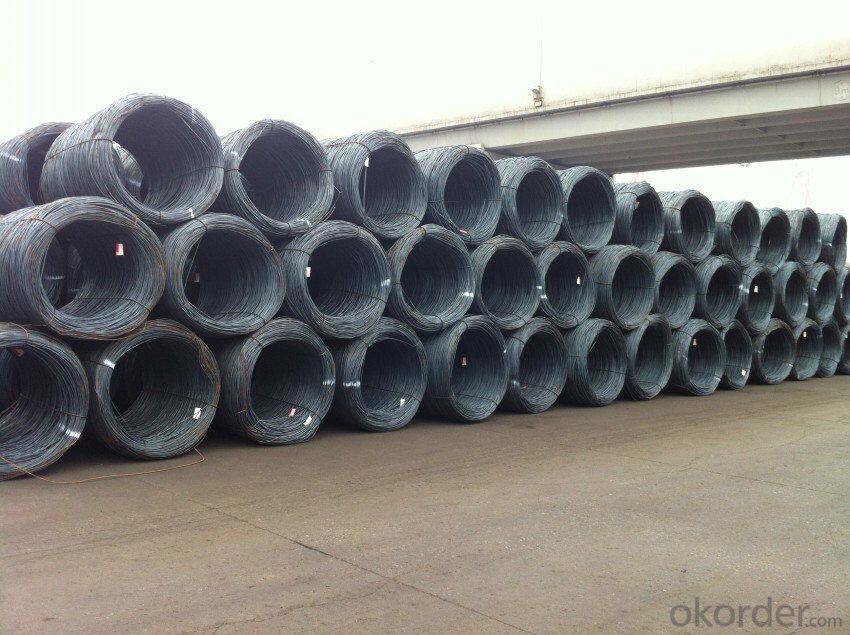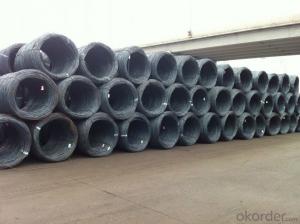Wholesale 5.5-14mm High Carbon Steel Wire Rod
- Loading Port:
- Tianjin
- Payment Terms:
- TT OR LC
- Min Order Qty:
- 25 m.t.
- Supply Capability:
- 5000 m.t./month
OKorder Service Pledge
OKorder Financial Service
You Might Also Like
Item specifice
Specifications of Steel Wire Rod in Coil:
Steel Grade: Q195/235, SAE1006-1018B Standard: ASTM, GB
Diameter: 5.5mm, 6.5mm, 7mm,8mm,9mm,10mm,12mm,14mm
Type: Drawn Wire Alloy or Not: Alloy Brand Name: HSKY
Technique: Hot Rolled Place of Origin: China Mainland
Chemical Composition:(Please kindly find our chemistry of our material based on SAE1006B and SAE1008B as below for your information)
High carbon/Low carbon/common carbon Steel wire rod | With boron for rebate tax |
Grade | SAE1006B SAE1008B SAE1018B |
Package | In coil ,in bundle, |
Coil weight | about 2000kg-3000kgs |
Size: | 5.5mm 6.5mm 8mm 10mm 12mm 14mm 16mm |
Types | High Carbon ,Low carbon ,Common carbon |
Exported Country | South Korea,Vietnam,Indonesia,Myanmar,Philippines and Afrca,Ect |
Delivery term: | within 30 days after receive the LC |
Payment Term: | LC at sight ,LC 30-120 days after B/L date, TT payment |
The Standard of Physical Properties:
Grade | Chemical Composition(%) | |||||
C | Mn | Si | S | P | Cr | |
SAE1006 | 0.03~O.07 | ≤0.32 | ≤0.30 | ≤0.045 | ≤0.040 | >0.30 |
Mechanical properties | ||||||
Yield strength(N/mm2) | Tensile strength(N/mm2) | Elongation(%) | ||||
250-280 | 350-380 | ≥32 | ||||
Grade | Chemical Composition(%) | |||||
C | Mn | Si | S | P | Cr | |
SAE1008 | 0.10max | 0.3~O.50 | 0.15max | 0.050max | 0.040 max | 0.30 min |
Mechanical properties | ||||||
Yield strength(N/mm2) | Tensile strength(N/mm2) | Elongation(%) | ||||
≥195 | 315-430 | ≥30 | ||||
Usage and Applications of Steel Wire Rod in Coil:
After hot-rolled the products shaped into coil and delivery as finished product, including round, square, rectangular, hexagonal and so on, Since most of the products are round, it is generally called wire rod. Steel wire rod is widely used in construction and manufacturing. Steel wire rod is mainly used for reinforcement of reinforced concrete and welded structure or reprocessed (roberts, nail etc) materials, especially used to produce wire drawing, welding electrode, nails,spring, electronic, precise machinery parts and so on.
Packaging & Delivery of Steel Wire Rod in Coil:
Packaging Detail: products are packed in coil and then shipped by container or bulk vessel
Each coil weight: 2-3MT
Delivery Detail: within 45 days after received deposit or LC.
Label: to be specified by customer, generally, each bundle has 1-2 labels
Trade terms: CFR, CIF


- Q:What are the different international specifications for steel wire rod?
- There are several international specifications for steel wire rod, including the ASTM (American Society for Testing and Materials) standards, the EN (European Norm) standards, and the JIS (Japanese Industrial Standards) standards. These specifications outline the requirements for various properties of steel wire rod, such as its chemical composition, mechanical properties, and dimensions. They ensure that steel wire rod produced and used globally meets specific quality and performance standards.
- Q:What are the different surface coatings available for steel wire rod?
- There are various surface coatings available for steel wire rods, including galvanized, zinc-coated, chrome-plated, and epoxy-coated. These coatings provide different levels of protection against corrosion, enhance the wire rod's durability, and improve its aesthetic appearance.
- Q:What are the different mechanical properties of steel wire rod?
- The different mechanical properties of steel wire rod include strength, elasticity, ductility, toughness, and hardness. These properties determine the wire rod's ability to withstand applied forces, resist deformation, exhibit flexibility, absorb energy, and resist wear and indentation, respectively.
- Q:What are the main factors influencing the choice of steel wire rod order payment terms options?
- The main factors influencing the choice of steel wire rod order payment terms options include the financial stability and creditworthiness of the buyer, the volume and frequency of the orders, the competitive landscape within the industry, the level of trust between the buyer and the seller, and the prevailing market conditions.
- Q:How is steel wire rod used in the manufacturing of wire rope anchors?
- Steel wire rod is used in the manufacturing of wire rope anchors as it serves as the primary material for creating the wire rope itself. The steel wire rod is processed and shaped into strands, which are then twisted and braided together to form a strong and durable wire rope. These wire ropes are then attached to the anchors, providing the necessary strength and stability required for various applications such as construction, maritime, and transportation industries.
- Q:How is steel wire rod used in the production of wire for automotive seat springs?
- Steel wire rod is used in the production of wire for automotive seat springs by being processed through various mechanical and heat treatments to enhance its strength and flexibility. This wire rod is then drawn into thinner wire strands that are coiled and formed into the spring shapes required for automotive seat applications. The high tensile strength of steel wire rod ensures that the seat springs can withstand the weight and pressure exerted on them, providing durability and comfort to the users.
- Q:How is steel wire rod used in the manufacturing of wire forms for household appliances?
- Steel wire rod is an essential component in the manufacturing of wire forms for household appliances. These wire forms are used in a wide range of applications, such as heating elements, fan guards, racks, and shelves. The process begins with the production of steel wire rod, which is a long, cylindrical piece of steel. This rod undergoes several manufacturing processes before it is transformed into wire forms. The first step is drawing, where the steel wire rod is pulled through a series of dies to reduce its diameter and increase its length. This process ensures that the wire has the desired thickness and strength. Once the wire is drawn, it is further processed to create various wire forms. For example, in the case of heating elements, the wire is coiled into a specific shape and size. This coiled wire is then typically passed through a heating process to improve its durability and resistance to heat. In the case of fan guards, the steel wire rod is bent and shaped into a circular or square pattern, forming a protective barrier around the fan blades. These wire forms are designed to prevent any objects or fingers from coming into contact with the blades while the fan is running. Similarly, for racks and shelves, the steel wire rod is bent and welded to create a sturdy and durable structure. These wire forms provide support and organization for various household appliances, such as ovens, refrigerators, and dishwashers. Overall, steel wire rod is a crucial material in the manufacturing of wire forms for household appliances. Its strength, flexibility, and durability make it an ideal choice for creating a wide range of wire forms that are essential for the functioning and safety of household appliances.
- Q:What are the main factors affecting the formability of steel wire rod?
- The main factors affecting the formability of steel wire rod include the composition of the steel, its microstructure, mechanical properties such as yield strength and ductility, as well as the processing conditions such as temperature, strain rate, and lubrication.
- Q:What are the different types of steel wire rod coatings available?
- Steel wire rods can be coated with various types of coatings, each offering unique advantages. Some common coatings include: 1. Galvanized Coating: Zinc is applied to the surface of the steel wire rod, providing excellent corrosion resistance. This makes it suitable for outdoor applications or environments with high humidity or exposure to corrosive substances. 2. Phosphating Coating: A chemical conversion process creates a thin layer of phosphate crystals on the surface of the steel wire rod. This coating improves adhesion, corrosion resistance, and acts as a good base for painting or further treatment. 3. Polymer Coating: Polyethylene or polypropylene coatings protect against corrosion, abrasion, and chemical exposure. These coatings are highly flexible and can be customized to meet specific requirements like UV resistance or electrical insulation. 4. Epoxy Coating: Known for exceptional adhesion and chemical resistance, epoxy coatings are commonly used in environments with harsh chemicals, like the oil and gas industry or marine environments. They also protect against corrosion and abrasion. 5. Zinc-Aluminum Coating: This coating involves applying a layer of zinc-aluminum alloy to the steel wire rod. It offers excellent corrosion resistance and is often used in applications requiring both corrosion and heat resistance, such as automotive or construction industries. 6. Copper Coating: Copper coatings are primarily used for their electrical conductivity properties. They enhance conductivity and reduce electrical resistance in steel wire rods used for electrical applications like wiring or cables. These examples highlight the various coatings available for steel wire rods. The selection depends on specific requirements like corrosion resistance, electrical conductivity, or chemical resistance. Choosing the appropriate coating ensures optimal performance and durability of the steel wire rods.
- Q:What are the typical mechanical properties of steel wire rod?
- The mechanical properties of steel wire rod can vary depending on the grade and composition of the steel used. However, there are commonly observed general mechanical properties in steel wire rods. Tensile strength is a crucial mechanical property of steel wire rod. Steel wire rods are known for their high tensile strength, which is the maximum stress or load they can withstand before breaking. The grade and processing of the steel determine the tensile strength, which can range from a few hundred megapascals (MPa) to several thousand MPa. Ductility is another important mechanical property of steel wire rod. Ductility refers to the ability of a material to undergo plastic deformation without fracturing. Steel wire rods have high ductility, allowing them to be easily shaped without breaking. This property is essential for applications that involve bending, twisting, or pulling the wire rod. Steel wire rods also have good toughness, which means they can absorb energy and resist fracture under impact or sudden loads. This makes them suitable for applications in industries like construction, automotive, or machinery. Moreover, steel wire rods have excellent corrosion resistance, especially when they are coated or treated to enhance their protective properties. This resistance is crucial in environments with harsh conditions or corrosive substances. Additionally, steel wire rods have good thermal and electrical conductivity, making them suitable for use in the electrical and electronics industries. It's worth noting that the specific mechanical properties of steel wire rods can be modified through processes like heat treatment, cold working, or alloying. Different grades of steel wire rods may have optimized mechanical properties for specific applications. In summary, steel wire rods possess high tensile strength, good ductility, toughness, corrosion resistance, and thermal and electrical conductivity. These properties make them versatile and widely used in various industries.
1. Manufacturer Overview |
|
|---|---|
| Location | |
| Year Established | |
| Annual Output Value | |
| Main Markets | |
| Company Certifications | |
2. Manufacturer Certificates |
|
|---|---|
| a) Certification Name | |
| Range | |
| Reference | |
| Validity Period | |
3. Manufacturer Capability |
|
|---|---|
| a)Trade Capacity | |
| Nearest Port | |
| Export Percentage | |
| No.of Employees in Trade Department | |
| Language Spoken: | |
| b)Factory Information | |
| Factory Size: | |
| No. of Production Lines | |
| Contract Manufacturing | |
| Product Price Range | |
Send your message to us
Wholesale 5.5-14mm High Carbon Steel Wire Rod
- Loading Port:
- Tianjin
- Payment Terms:
- TT OR LC
- Min Order Qty:
- 25 m.t.
- Supply Capability:
- 5000 m.t./month
OKorder Service Pledge
OKorder Financial Service
Similar products
New products
Hot products
Related keywords




























